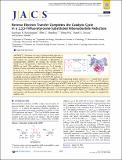Reverse Electron Transfer Completes the Catalytic Cycle in a 2,3,5-Trifluorotyrosine-Substituted Ribonucleotide Reductase
Author(s)
Ravichandran, Kanchana; Minnihan, Ellen Catherine; Wei, Yifeng; Stubbe, JoAnne; Nocera, Daniel G., 1957-
DownloadNocera_Reverse Electron Transfer.pdf (2.009Mb)
PUBLISHER_CC
Publisher with Creative Commons License
Creative Commons Attribution
Terms of use
Metadata
Show full item recordAbstract
Escherichia coli class Ia ribonucleotide reductase is composed of two subunits (α and β), which form an α2β2 complex that catalyzes the conversion of nucleoside 5′-diphosphates to deoxynucleotides (dNDPs). β2 contains the essential tyrosyl radical (Y[subscript 122][superscript •]) that generates a thiyl radical (C[subscript 439][superscript •]) in α2 where dNDPs are made. This oxidation occurs over 35 Å through a pathway of amino acid radical intermediates (Y[subscript 122] → [W[subscript 48]] → Y[subscript 356] in β2 to Y[subscript 731] → Y[subscript 730] → C[subscrip 439] in α2). However, chemistry is preceded by a slow protein conformational change(s) that prevents observation of these intermediates. 2,3,5-Trifluorotyrosine site-specifically inserted at position 122 of β2 (F[subscript 3]Y[superscript •]-β2) perturbs its conformation and the driving force for radical propagation, while maintaining catalytic activity (1.7 s[superscript –1]). Rapid freeze–quench electron paramagnetic resonance spectroscopy and rapid chemical-quench analysis of the F[subscript 3]Y[superscript •]-β2, α2, CDP, and ATP (effector) reaction show generation of 0.5 equiv of Y[subscript 356] and 0.5 equiv of dCDP, both at 30 s[superscript –1]. In the absence of an external reducing system, Y[subscript 356] reduction occurs concomitant with F3Y reoxidation (0.4 s–1) and subsequent to oxidation of all α2s. In the presence of a reducing system, a burst of dCDP (0.4 equiv at 22 s–1) is observed prior to steady-state turnover (1.7 s–1). The [Y[subscript 356][superescript •]] does not change, consistent with rate-limiting F[subscript 3]Y reoxidation. The data support a mechanism where Y[subscript 122][superscript •] is reduced and reoxidized on each turnover and demonstrate for the first time the ability of a pathway radical in an active α2β2 complex to complete the catalytic cycle.
Date issued
2015-10Department
Massachusetts Institute of Technology. Department of Biology; Massachusetts Institute of Technology. Department of ChemistryJournal
Journal of the American Chemical Society
Publisher
American Chemical Society (ACS)
Citation
Ravichandran, Kanchana R. et al. “Reverse Electron Transfer Completes the Catalytic Cycle in a 2,3,5-Trifluorotyrosine-Substituted Ribonucleotide Reductase.” Journal of the American Chemical Society 137.45 (2015): 14387–14395. © 2015 American Chemical Society
Version: Final published version
ISSN
0002-7863
1520-5126